ITECH 7401 Leadership in IT Project Management: Team Leadership Blog
VerifiedAdded on 2023/03/30
|7
|1215
|328
Report
AI Summary
This report is a team leadership blog analyzing the research paper "Project Management: Recent Developments and Research Opportunities" by Nicholas Hall. The blog evaluates the fundamental ideas behind project management, its history, and recent developments, including the rise of agile methodologies. It discusses the significance of project management in business, its evolution, and various research methodologies used to gather data. The blog also identifies the advantages and limitations of the research paper, concluding that project management is crucial for improving project performance. It provides lessons for IT managers and highlights the importance of understanding project management methodologies and research opportunities. This assignment is available on Desklib, a platform offering a wide range of study resources, including past papers and solved assignments, to support students in their academic endeavors.
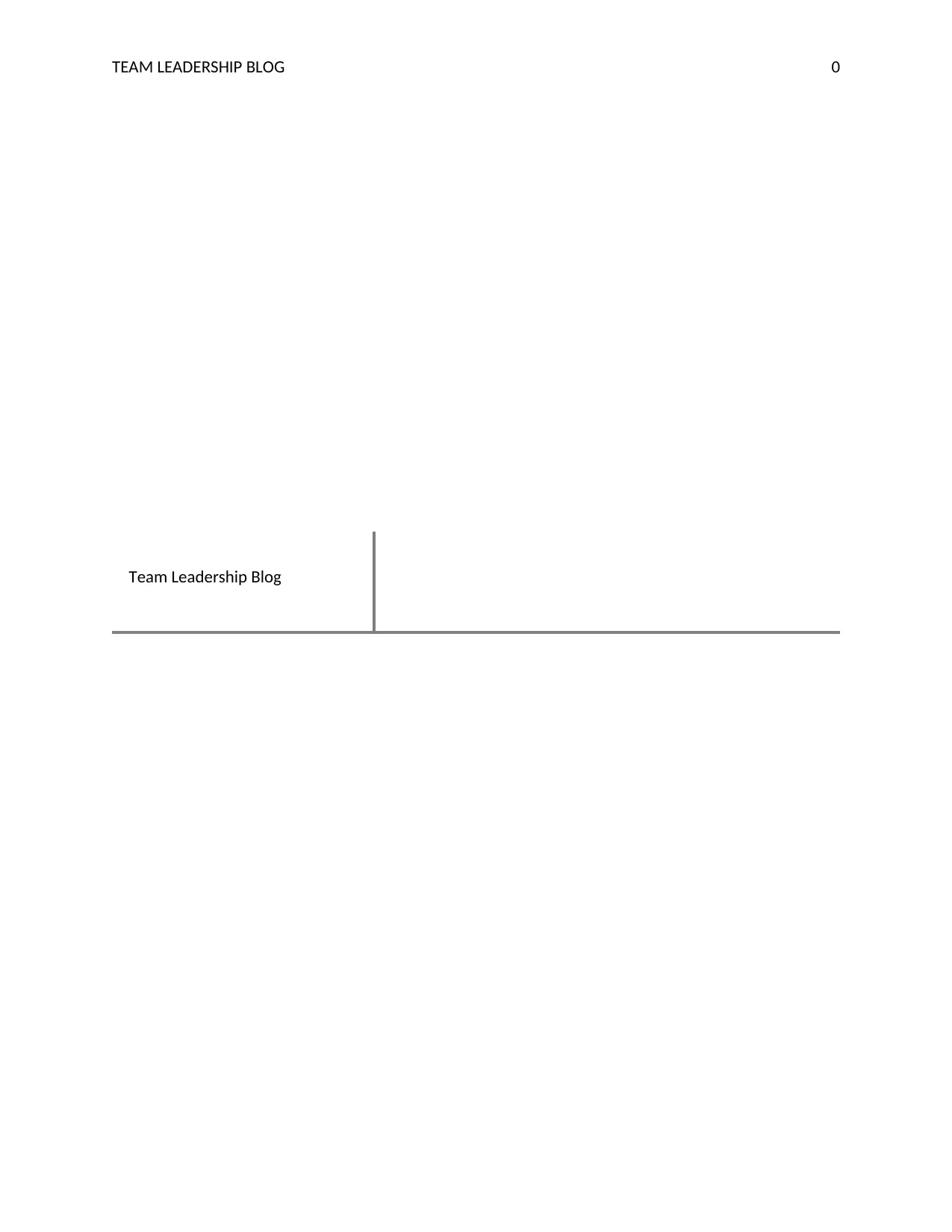
TEAM LEADERSHIP BLOG 0
Team Leadership Blog
Team Leadership Blog
Paraphrase This Document
Need a fresh take? Get an instant paraphrase of this document with our AI Paraphraser

TEAM LEADERSHIP BLOG 1
Table of Contents
Introduction.................................................................................................................................................2
Analysis........................................................................................................................................................2
Conclusion...................................................................................................................................................4
Lessons for the IT manager..........................................................................................................................4
References...................................................................................................................................................5
Table of Contents
Introduction.................................................................................................................................................2
Analysis........................................................................................................................................................2
Conclusion...................................................................................................................................................4
Lessons for the IT manager..........................................................................................................................4
References...................................................................................................................................................5
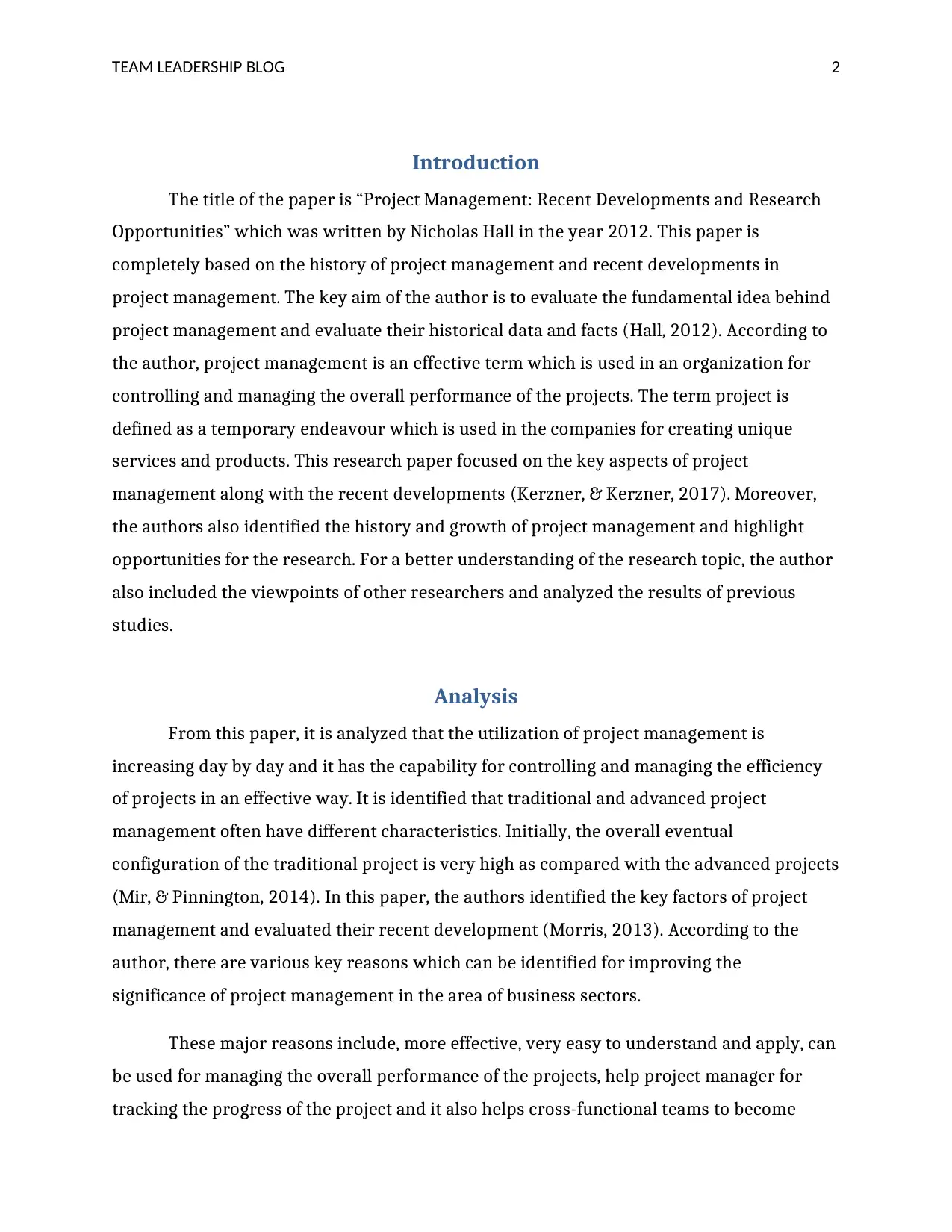
TEAM LEADERSHIP BLOG 2
Introduction
The title of the paper is “Project Management: Recent Developments and Research
Opportunities” which was written by Nicholas Hall in the year 2012. This paper is
completely based on the history of project management and recent developments in
project management. The key aim of the author is to evaluate the fundamental idea behind
project management and evaluate their historical data and facts (Hall, 2012). According to
the author, project management is an effective term which is used in an organization for
controlling and managing the overall performance of the projects. The term project is
defined as a temporary endeavour which is used in the companies for creating unique
services and products. This research paper focused on the key aspects of project
management along with the recent developments (Kerzner, & Kerzner, 2017). Moreover,
the authors also identified the history and growth of project management and highlight
opportunities for the research. For a better understanding of the research topic, the author
also included the viewpoints of other researchers and analyzed the results of previous
studies.
Analysis
From this paper, it is analyzed that the utilization of project management is
increasing day by day and it has the capability for controlling and managing the efficiency
of projects in an effective way. It is identified that traditional and advanced project
management often have different characteristics. Initially, the overall eventual
configuration of the traditional project is very high as compared with the advanced projects
(Mir, & Pinnington, 2014). In this paper, the authors identified the key factors of project
management and evaluated their recent development (Morris, 2013). According to the
author, there are various key reasons which can be identified for improving the
significance of project management in the area of business sectors.
These major reasons include, more effective, very easy to understand and apply, can
be used for managing the overall performance of the projects, help project manager for
tracking the progress of the project and it also helps cross-functional teams to become
Introduction
The title of the paper is “Project Management: Recent Developments and Research
Opportunities” which was written by Nicholas Hall in the year 2012. This paper is
completely based on the history of project management and recent developments in
project management. The key aim of the author is to evaluate the fundamental idea behind
project management and evaluate their historical data and facts (Hall, 2012). According to
the author, project management is an effective term which is used in an organization for
controlling and managing the overall performance of the projects. The term project is
defined as a temporary endeavour which is used in the companies for creating unique
services and products. This research paper focused on the key aspects of project
management along with the recent developments (Kerzner, & Kerzner, 2017). Moreover,
the authors also identified the history and growth of project management and highlight
opportunities for the research. For a better understanding of the research topic, the author
also included the viewpoints of other researchers and analyzed the results of previous
studies.
Analysis
From this paper, it is analyzed that the utilization of project management is
increasing day by day and it has the capability for controlling and managing the efficiency
of projects in an effective way. It is identified that traditional and advanced project
management often have different characteristics. Initially, the overall eventual
configuration of the traditional project is very high as compared with the advanced projects
(Mir, & Pinnington, 2014). In this paper, the authors identified the key factors of project
management and evaluated their recent development (Morris, 2013). According to the
author, there are various key reasons which can be identified for improving the
significance of project management in the area of business sectors.
These major reasons include, more effective, very easy to understand and apply, can
be used for managing the overall performance of the projects, help project manager for
tracking the progress of the project and it also helps cross-functional teams to become
⊘ This is a preview!⊘
Do you want full access?
Subscribe today to unlock all pages.

Trusted by 1+ million students worldwide
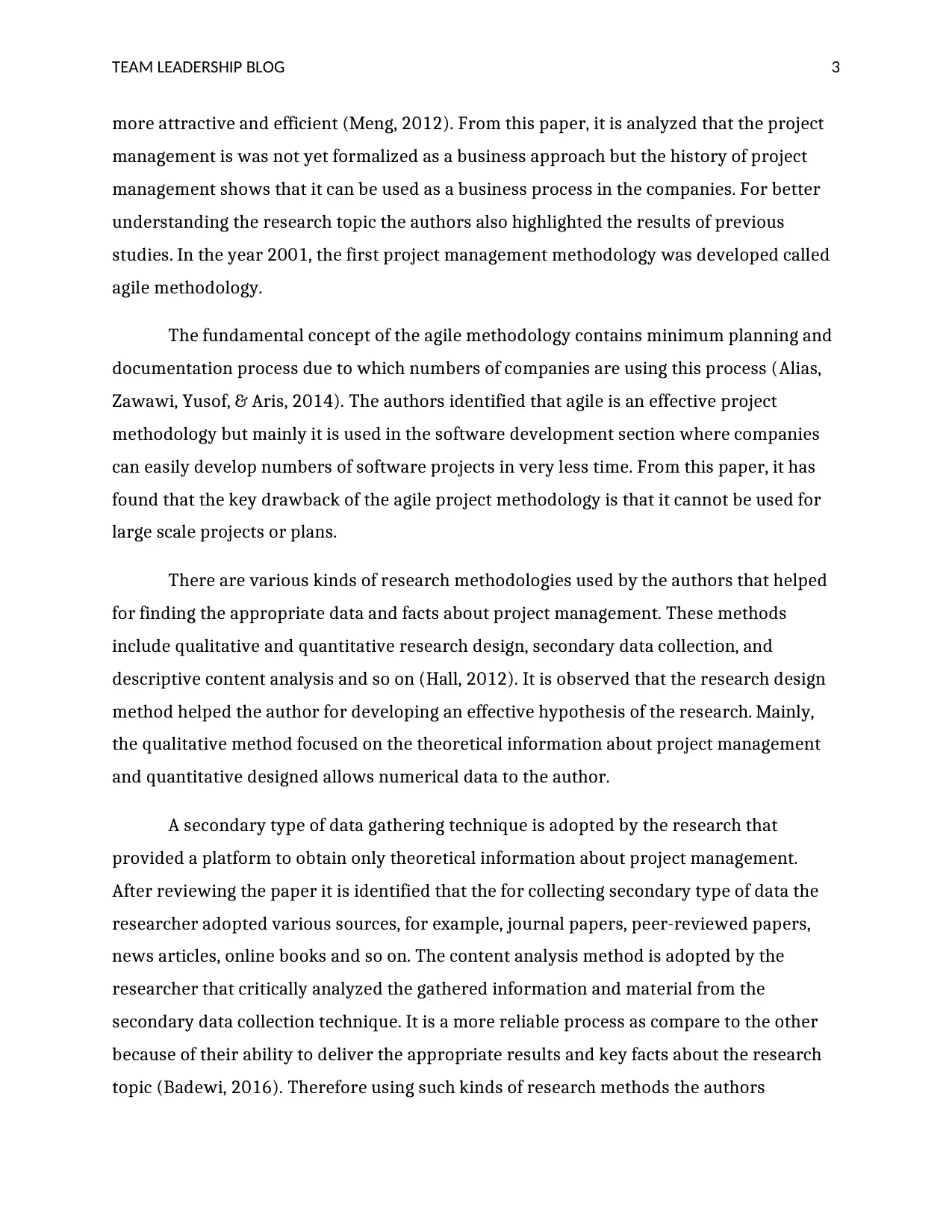
TEAM LEADERSHIP BLOG 3
more attractive and efficient (Meng, 2012). From this paper, it is analyzed that the project
management is was not yet formalized as a business approach but the history of project
management shows that it can be used as a business process in the companies. For better
understanding the research topic the authors also highlighted the results of previous
studies. In the year 2001, the first project management methodology was developed called
agile methodology.
The fundamental concept of the agile methodology contains minimum planning and
documentation process due to which numbers of companies are using this process (Alias,
Zawawi, Yusof, & Aris, 2014). The authors identified that agile is an effective project
methodology but mainly it is used in the software development section where companies
can easily develop numbers of software projects in very less time. From this paper, it has
found that the key drawback of the agile project methodology is that it cannot be used for
large scale projects or plans.
There are various kinds of research methodologies used by the authors that helped
for finding the appropriate data and facts about project management. These methods
include qualitative and quantitative research design, secondary data collection, and
descriptive content analysis and so on (Hall, 2012). It is observed that the research design
method helped the author for developing an effective hypothesis of the research. Mainly,
the qualitative method focused on the theoretical information about project management
and quantitative designed allows numerical data to the author.
A secondary type of data gathering technique is adopted by the research that
provided a platform to obtain only theoretical information about project management.
After reviewing the paper it is identified that the for collecting secondary type of data the
researcher adopted various sources, for example, journal papers, peer-reviewed papers,
news articles, online books and so on. The content analysis method is adopted by the
researcher that critically analyzed the gathered information and material from the
secondary data collection technique. It is a more reliable process as compare to the other
because of their ability to deliver the appropriate results and key facts about the research
topic (Badewi, 2016). Therefore using such kinds of research methods the authors
more attractive and efficient (Meng, 2012). From this paper, it is analyzed that the project
management is was not yet formalized as a business approach but the history of project
management shows that it can be used as a business process in the companies. For better
understanding the research topic the authors also highlighted the results of previous
studies. In the year 2001, the first project management methodology was developed called
agile methodology.
The fundamental concept of the agile methodology contains minimum planning and
documentation process due to which numbers of companies are using this process (Alias,
Zawawi, Yusof, & Aris, 2014). The authors identified that agile is an effective project
methodology but mainly it is used in the software development section where companies
can easily develop numbers of software projects in very less time. From this paper, it has
found that the key drawback of the agile project methodology is that it cannot be used for
large scale projects or plans.
There are various kinds of research methodologies used by the authors that helped
for finding the appropriate data and facts about project management. These methods
include qualitative and quantitative research design, secondary data collection, and
descriptive content analysis and so on (Hall, 2012). It is observed that the research design
method helped the author for developing an effective hypothesis of the research. Mainly,
the qualitative method focused on the theoretical information about project management
and quantitative designed allows numerical data to the author.
A secondary type of data gathering technique is adopted by the research that
provided a platform to obtain only theoretical information about project management.
After reviewing the paper it is identified that the for collecting secondary type of data the
researcher adopted various sources, for example, journal papers, peer-reviewed papers,
news articles, online books and so on. The content analysis method is adopted by the
researcher that critically analyzed the gathered information and material from the
secondary data collection technique. It is a more reliable process as compare to the other
because of their ability to deliver the appropriate results and key facts about the research
topic (Badewi, 2016). Therefore using such kinds of research methods the authors
Paraphrase This Document
Need a fresh take? Get an instant paraphrase of this document with our AI Paraphraser
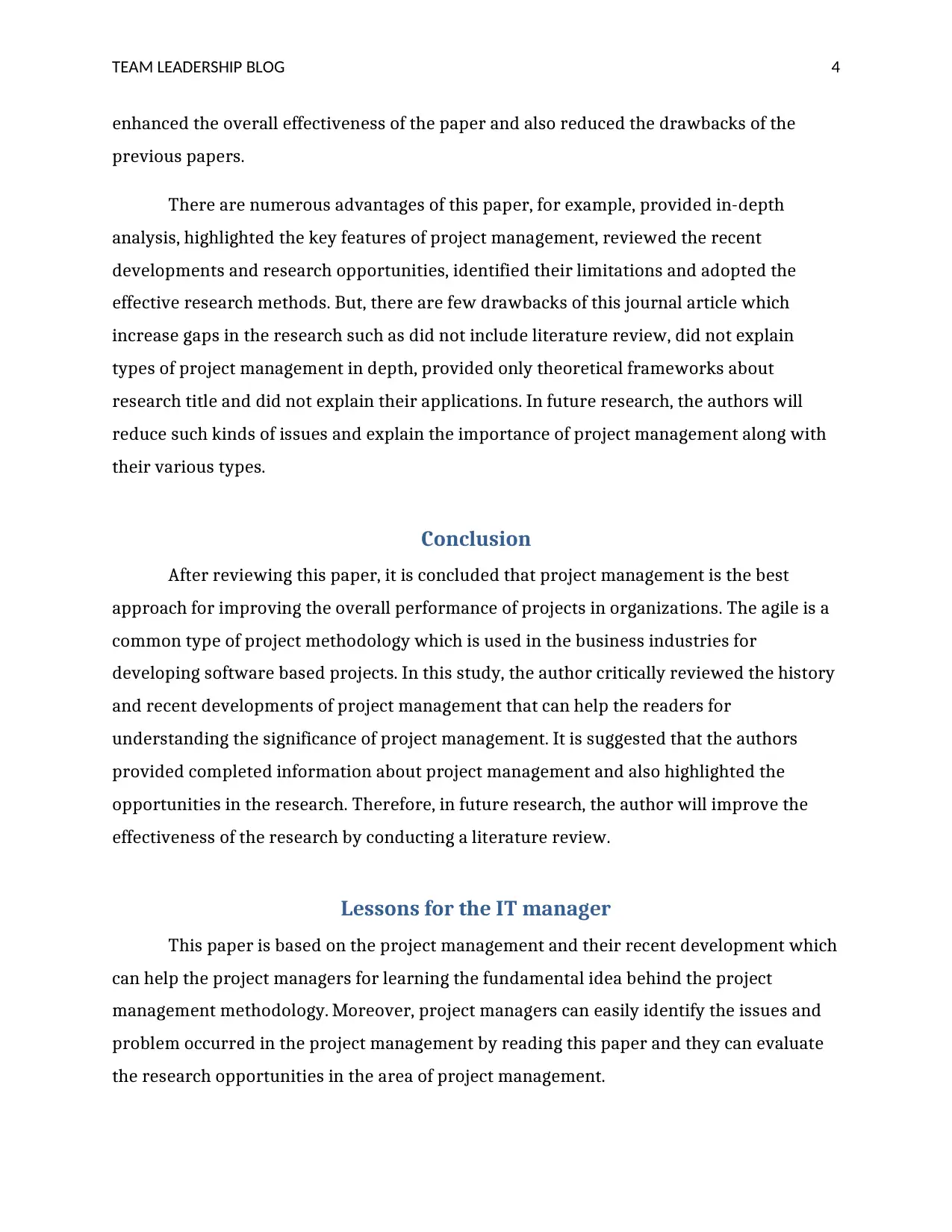
TEAM LEADERSHIP BLOG 4
enhanced the overall effectiveness of the paper and also reduced the drawbacks of the
previous papers.
There are numerous advantages of this paper, for example, provided in-depth
analysis, highlighted the key features of project management, reviewed the recent
developments and research opportunities, identified their limitations and adopted the
effective research methods. But, there are few drawbacks of this journal article which
increase gaps in the research such as did not include literature review, did not explain
types of project management in depth, provided only theoretical frameworks about
research title and did not explain their applications. In future research, the authors will
reduce such kinds of issues and explain the importance of project management along with
their various types.
Conclusion
After reviewing this paper, it is concluded that project management is the best
approach for improving the overall performance of projects in organizations. The agile is a
common type of project methodology which is used in the business industries for
developing software based projects. In this study, the author critically reviewed the history
and recent developments of project management that can help the readers for
understanding the significance of project management. It is suggested that the authors
provided completed information about project management and also highlighted the
opportunities in the research. Therefore, in future research, the author will improve the
effectiveness of the research by conducting a literature review.
Lessons for the IT manager
This paper is based on the project management and their recent development which
can help the project managers for learning the fundamental idea behind the project
management methodology. Moreover, project managers can easily identify the issues and
problem occurred in the project management by reading this paper and they can evaluate
the research opportunities in the area of project management.
enhanced the overall effectiveness of the paper and also reduced the drawbacks of the
previous papers.
There are numerous advantages of this paper, for example, provided in-depth
analysis, highlighted the key features of project management, reviewed the recent
developments and research opportunities, identified their limitations and adopted the
effective research methods. But, there are few drawbacks of this journal article which
increase gaps in the research such as did not include literature review, did not explain
types of project management in depth, provided only theoretical frameworks about
research title and did not explain their applications. In future research, the authors will
reduce such kinds of issues and explain the importance of project management along with
their various types.
Conclusion
After reviewing this paper, it is concluded that project management is the best
approach for improving the overall performance of projects in organizations. The agile is a
common type of project methodology which is used in the business industries for
developing software based projects. In this study, the author critically reviewed the history
and recent developments of project management that can help the readers for
understanding the significance of project management. It is suggested that the authors
provided completed information about project management and also highlighted the
opportunities in the research. Therefore, in future research, the author will improve the
effectiveness of the research by conducting a literature review.
Lessons for the IT manager
This paper is based on the project management and their recent development which
can help the project managers for learning the fundamental idea behind the project
management methodology. Moreover, project managers can easily identify the issues and
problem occurred in the project management by reading this paper and they can evaluate
the research opportunities in the area of project management.

TEAM LEADERSHIP BLOG 5
⊘ This is a preview!⊘
Do you want full access?
Subscribe today to unlock all pages.

Trusted by 1+ million students worldwide
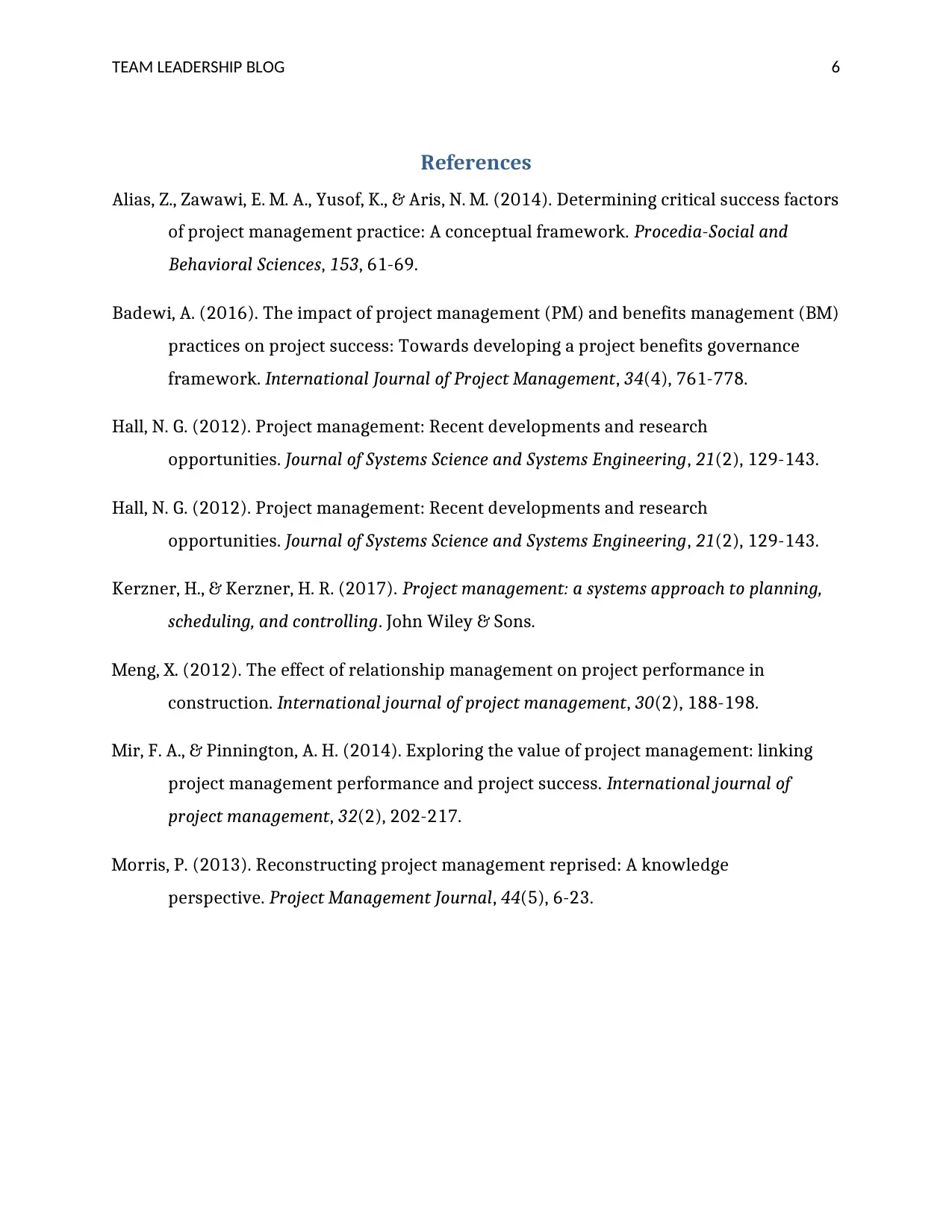
TEAM LEADERSHIP BLOG 6
References
Alias, Z., Zawawi, E. M. A., Yusof, K., & Aris, N. M. (2014). Determining critical success factors
of project management practice: A conceptual framework. Procedia-Social and
Behavioral Sciences, 153, 61-69.
Badewi, A. (2016). The impact of project management (PM) and benefits management (BM)
practices on project success: Towards developing a project benefits governance
framework. International Journal of Project Management, 34(4), 761-778.
Hall, N. G. (2012). Project management: Recent developments and research
opportunities. Journal of Systems Science and Systems Engineering, 21(2), 129-143.
Hall, N. G. (2012). Project management: Recent developments and research
opportunities. Journal of Systems Science and Systems Engineering, 21(2), 129-143.
Kerzner, H., & Kerzner, H. R. (2017). Project management: a systems approach to planning,
scheduling, and controlling. John Wiley & Sons.
Meng, X. (2012). The effect of relationship management on project performance in
construction. International journal of project management, 30(2), 188-198.
Mir, F. A., & Pinnington, A. H. (2014). Exploring the value of project management: linking
project management performance and project success. International journal of
project management, 32(2), 202-217.
Morris, P. (2013). Reconstructing project management reprised: A knowledge
perspective. Project Management Journal, 44(5), 6-23.
References
Alias, Z., Zawawi, E. M. A., Yusof, K., & Aris, N. M. (2014). Determining critical success factors
of project management practice: A conceptual framework. Procedia-Social and
Behavioral Sciences, 153, 61-69.
Badewi, A. (2016). The impact of project management (PM) and benefits management (BM)
practices on project success: Towards developing a project benefits governance
framework. International Journal of Project Management, 34(4), 761-778.
Hall, N. G. (2012). Project management: Recent developments and research
opportunities. Journal of Systems Science and Systems Engineering, 21(2), 129-143.
Hall, N. G. (2012). Project management: Recent developments and research
opportunities. Journal of Systems Science and Systems Engineering, 21(2), 129-143.
Kerzner, H., & Kerzner, H. R. (2017). Project management: a systems approach to planning,
scheduling, and controlling. John Wiley & Sons.
Meng, X. (2012). The effect of relationship management on project performance in
construction. International journal of project management, 30(2), 188-198.
Mir, F. A., & Pinnington, A. H. (2014). Exploring the value of project management: linking
project management performance and project success. International journal of
project management, 32(2), 202-217.
Morris, P. (2013). Reconstructing project management reprised: A knowledge
perspective. Project Management Journal, 44(5), 6-23.
1 out of 7
Related Documents
Your All-in-One AI-Powered Toolkit for Academic Success.
+13062052269
info@desklib.com
Available 24*7 on WhatsApp / Email
![[object Object]](/_next/static/media/star-bottom.7253800d.svg)
Unlock your academic potential
Copyright © 2020–2025 A2Z Services. All Rights Reserved. Developed and managed by ZUCOL.




